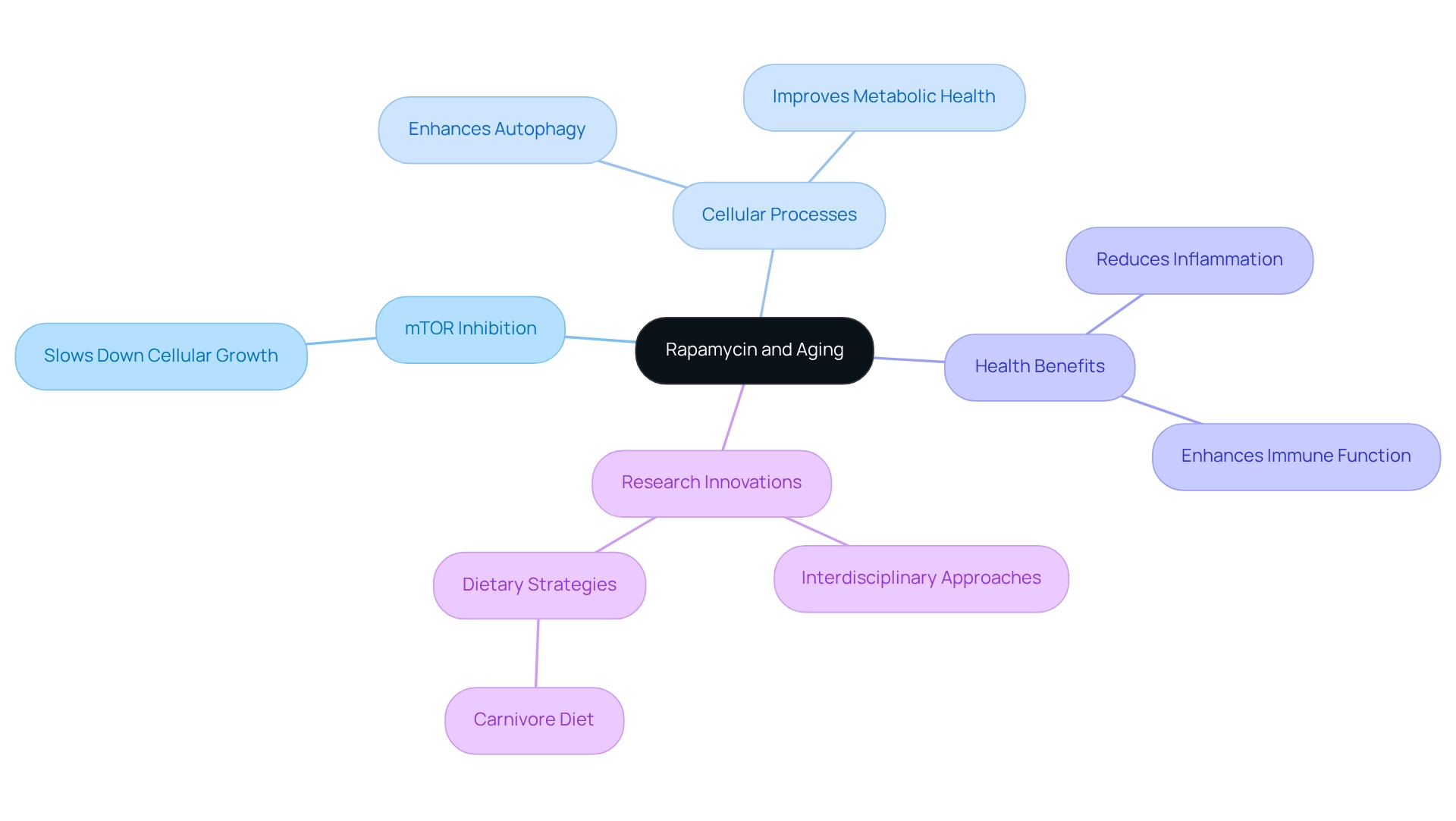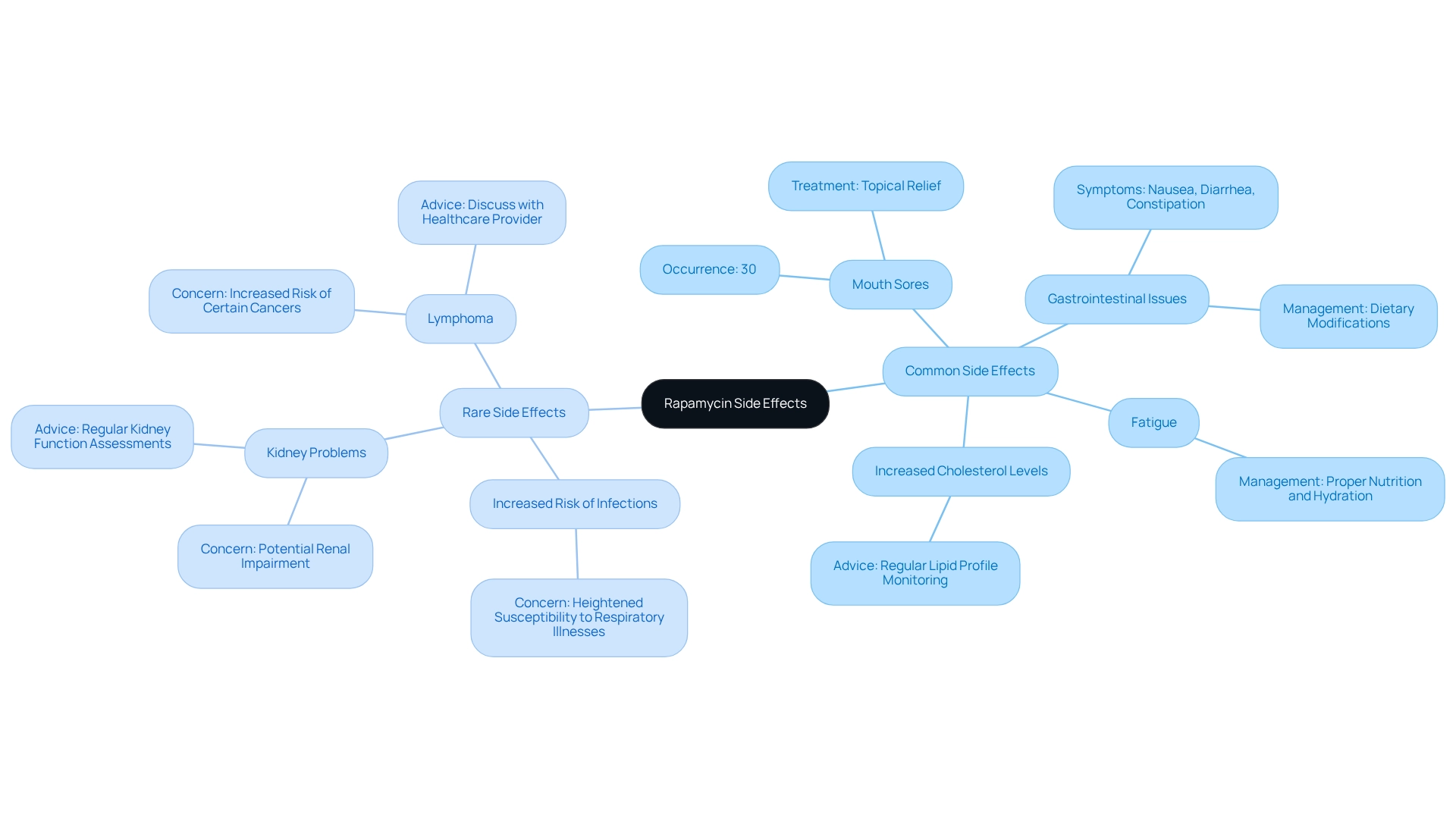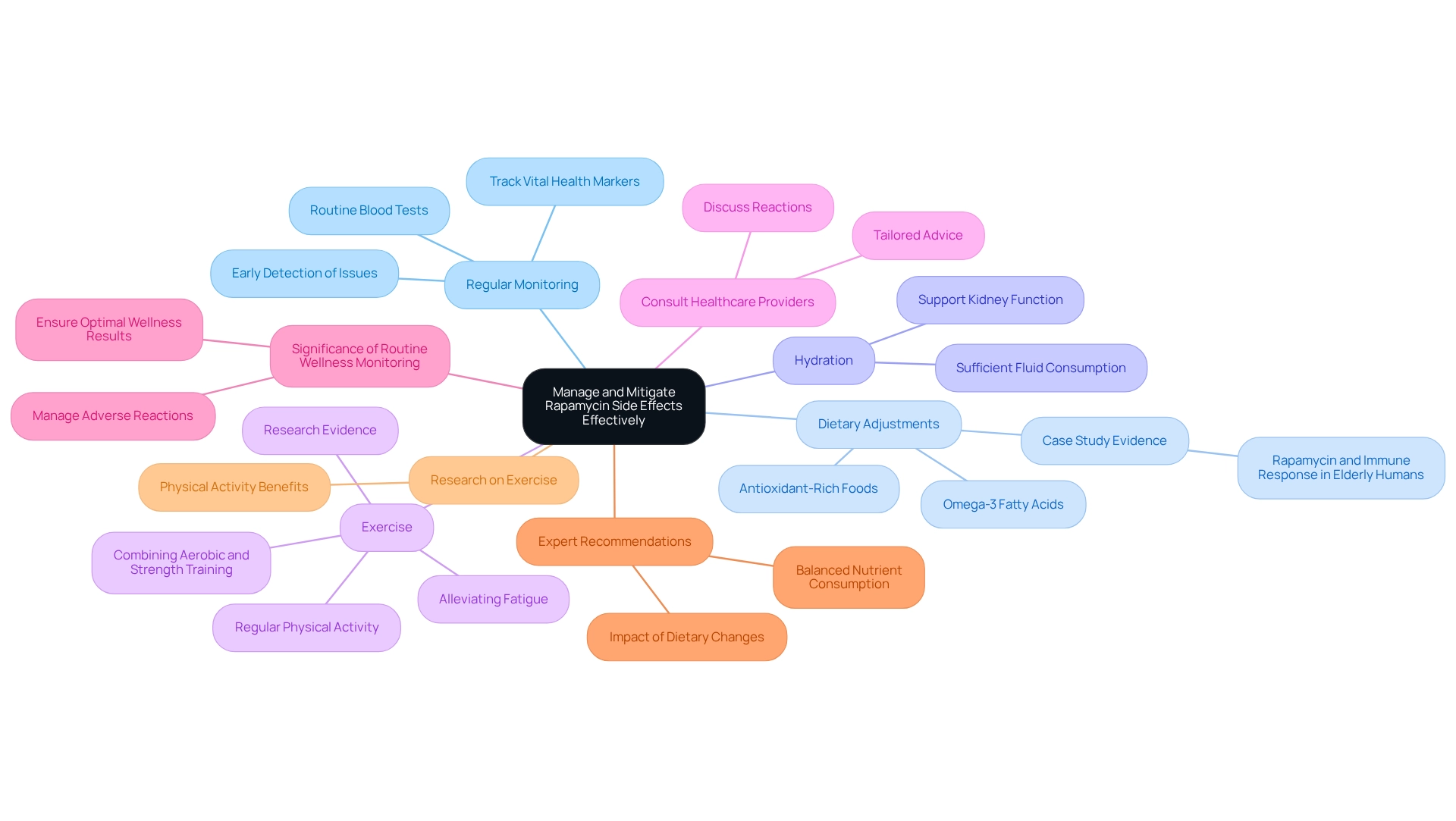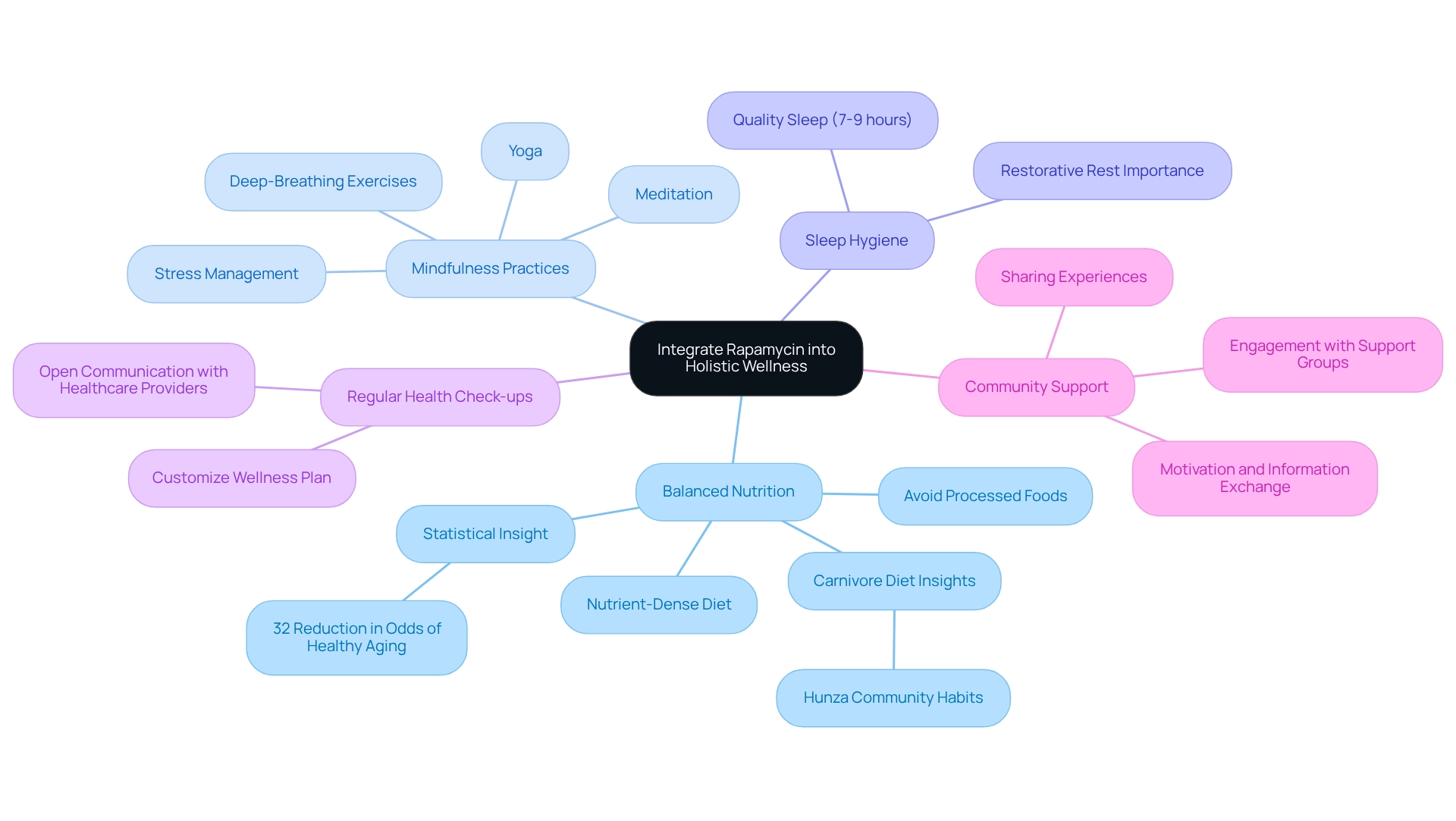Understanding Rapamycin Side Effects: Identification and Management
Overview
This article primarily focuses on identifying and managing the side effects of rapamycin, a drug known for its potential anti-aging benefits. It details both common and rare adverse reactions associated with its use. Furthermore, it emphasizes the importance of:
- Monitoring health markers
- Making dietary adjustments
- Consulting healthcare professionals
These steps are crucial to effectively mitigate side effects, thereby ensuring the safe application of rapamycin in wellness regimens. By understanding these factors, individuals can make informed decisions about incorporating rapamycin into their health practices.
Introduction
In the quest for longevity and improved health, rapamycin emerges as a revolutionary compound that has garnered the attention of both researchers and health enthusiasts. This compound is renowned for its ability to inhibit the mTOR pathway, which may slow cellular aging and enhance overall well-being by promoting essential processes such as autophagy.
Furthermore, as studies unveil its potential to combat age-related diseases and improve metabolic health, the discussion naturally expands to encompass the management of its side effects and the integration of this powerful drug into a holistic wellness strategy.
By delving into the multifaceted benefits and considerations surrounding rapamycin, individuals can better navigate their journey toward a healthier, longer life.
Explore Rapamycin: Uses and Mechanisms in Aging
Sirolimus, a powerful mTOR (mechanistic target of mTOR) inhibitor, has garnered significant interest for its potential anti-aging benefits. By inhibiting the mTOR pathway, this compound can slow down cellular growth and proliferation—processes that typically accelerate with age. This mechanism is believed to extend lifespan and improve healthspan by reducing the incidence of age-related diseases.
Studies indicate that sirolimus can enhance autophagy, a crucial cellular cleanup process that eliminates damaged components, thereby promoting cellular well-being and longevity. Furthermore, this compound has demonstrated improvements in metabolic health, reduced inflammation, and enhanced immune function, positioning it as a promising candidate in the field of longevity research.
Innovative research, such as Dr. Dituri’s groundbreaking underwater study, suggests that environmental factors also significantly influence aging. This interdisciplinary approach emphasizes the potential of combining dietary strategies, such as a carnivore diet, with innovative therapies like rapamycin to create a comprehensive anti-aging regimen. How might these insights shape future longevity strategies? Exploring these combinations could lead to exciting advancements in health and wellness.

Identify Common and Rare Side Effects of Rapamycin
Rapamycin can lead to a variety of reactions, known as rapamycin side effects, which can be categorized into common and uncommon instances. Frequent reactions include:
- Mouth sores: Often manifesting as canker sores, these painful lesions may necessitate topical treatments for relief. Research indicates that approximately 30% of users experience mouth sores, underscoring the significance of this adverse outcome.
- Gastrointestinal issues: Users commonly report nausea, diarrhea, and constipation, which can often be managed through dietary modifications.
- Fatigue: A notable number of users report increased tiredness, which can be alleviated by ensuring proper nutrition and hydration.
- Increased cholesterol levels: Regular monitoring of lipid profiles is advisable, as this drug has been shown to elevate cholesterol and triglyceride levels.
In contrast, rare adverse outcomes may include:
- Increased risk of infections: Due to its immunosuppressive properties, users may face a heightened susceptibility to infections, particularly respiratory illnesses.
- Kidney problems: Prolonged use of this medication can lead to renal impairment, making regular kidney function assessments essential.
- Lymphoma: There is a potential increased risk of certain cancers, including lymphoma, which warrants discussion with a healthcare provider.
Dr. Alan Green, a trailblazer in recommending this medication, emphasizes the importance of observing these reactions during consultations. A study assessing sirolimus’s impact on various wellness parameters highlighted the need for awareness concerning adverse reactions. Medical experts underline that while this drug can offer wellness advantages, understanding and managing the rapamycin side effects is essential for its safe application.

Manage and Mitigate Rapamycin Side Effects Effectively
To effectively manage and mitigate rapamycin side effects, consider implementing the following strategies:
- Regular Monitoring: Schedule routine blood tests to track cholesterol levels, kidney function, and other vital health markers. This proactive approach enables early detection of potential issues, ensuring timely intervention. Notably, the combined medication given was only comparable to roughly 28% of the intended dosage, emphasizing the necessity of monitoring.
- Dietary Adjustments: Emphasize a diet rich in antioxidants and omega-3 fatty acids to combat inflammation and bolster overall health. Including foods like fatty fish, nuts, and leafy greens can greatly improve well-being for individuals taking this medication. Data from case studies, such as ‘Rapamycin and Immune Response in Elderly Humans,’ suggests that dietary interventions can effectively manage the rapamycin side effects associated with this compound.
- Hydration: Maintain sufficient fluid consumption to ease gastrointestinal issues and support kidney function, which is vital for individuals using the medication.
- Exercise: Engage in regular physical activity, combining aerobic and strength-training exercises. This not only improves metabolic wellness but also helps in combating fatigue, a frequent consequence of the rapamycin side effects. Studies suggest that physical activity may alleviate certain consequences related to this drug, highlighting its significance in a holistic health plan.
- Consult Healthcare Providers: Always discuss any reactions with a healthcare professional. They can provide tailored advice, including potential dosage adjustments or additional therapies to alleviate symptoms. Nutritionists suggest particular dietary changes that can be crucial in managing the rapamycin side effects, highlighting the necessity for a balanced consumption of essential nutrients.
- Significance of Routine Wellness Monitoring: Routine evaluations are crucial for individuals on the medication, as they assist in managing adverse reactions effectively and ensuring optimal wellness results.
- Expert Recommendations: Nutritionists indicate that dietary changes can have a considerable impact on handling rapamycin-related issues, highlighting the importance of a balanced consumption of essential nutrients. Mannick et al. found that in a study where 264 elderly subjects were given the rapalog, RAD001 for 6 weeks, the antibody titers to influenza virus vaccine were significantly higher in the rapamycin-treated subjects a year after treatment.
- Research on Exercise: Studies suggest that physical activity may reduce certain consequences linked to this drug, emphasizing its significance in a holistic wellness approach.
- Case studies provide evidence that dietary interventions can effectively manage rapamycin side effects, reinforcing the importance of personalized nutrition plans.

Integrate Rapamycin into a Holistic Wellness Approach
Integrating rapamycin into a holistic wellness approach involves several essential components:
- Balanced Nutrition: Emphasize a nutrient-dense diet rich in high-quality animal-based foods, particularly those aligned with a carnivore diet, which are vital for providing essential nutrients that promote overall health and longevity. As observed in the habits of the Hunza community, known for their extraordinary lifespan, a diet rich in quality animal-derived foods can greatly enhance well-being. Christina Palmer, MD, a board-certified family physician, states, “Even though there’s no ‘one-size-fits-all’ diet for a long life, it’s important to eat nutrient-dense foods, healthy proteins, and fats, and to avoid processed foods.” Research indicates that higher consumption of nutrient-dense foods correlates with a 32% reduction in the odds of healthy aging (95% CI = 27–37%), underscoring the importance of dietary choices.
Incorporate practices such as meditation, yoga, or deep-breathing exercises for mindfulness and stress management to mitigate stress, which can negatively impact well-being and amplify the rapamycin side effects. Mindfulness has been demonstrated to improve overall well-being and resilience, with studies indicating its positive influence on wellness outcomes.
- Sleep Hygiene: Prioritize quality sleep, aiming for 7-9 hours of restorative rest each night. Sufficient sleep is essential for recovery and sustaining optimal well-being, especially when incorporating new supplements into your routine. As observed by various wellness enthusiasts, enhancing sleep quality can significantly improve overall well-being and longevity.
- Regular Health Check-ups: Foster open communication with healthcare providers to customize your wellness plan. Routine examinations ensure that the rapamycin side effects align with your wellness goals and allow for adjustments based on personal requirements.
- Community Support: Engage with support groups or online communities dedicated to longevity and wellness. Sharing experiences and insights with others on similar journeys can provide motivation and valuable information, enhancing your holistic approach to health. This community aspect reinforces the importance of collective experiences in achieving wellness goals.

Conclusion
Rapamycin stands out as a compelling compound in the pursuit of longevity and improved health. Its ability to inhibit the mTOR pathway not only slows cellular aging but also enhances vital processes such as autophagy, contributing to overall cellular health. Research surrounding rapamycin reveals its potential to combat age-related diseases, improve metabolic health, and bolster immune function, making it a valuable addition to a holistic wellness strategy.
However, like any powerful intervention, rapamycin comes with a range of potential side effects. Understanding and managing these effects—ranging from common issues like mouth sores and gastrointestinal disturbances to more serious risks such as infections and kidney problems—are crucial for safe usage. By implementing strategies such as regular monitoring, dietary adjustments, and maintaining open communication with healthcare providers, individuals can effectively mitigate these side effects while reaping the benefits of rapamycin.
Integrating rapamycin into a comprehensive wellness approach involves prioritizing balanced nutrition, mindfulness, and regular health check-ups. By adopting a nutrient-dense diet, engaging in stress management practices, and fostering community support, individuals can enhance their overall well-being and longevity. As interest in rapamycin continues to grow, it becomes increasingly important to approach its use thoughtfully and strategically, ensuring that it serves as a valuable tool in the journey toward a healthier, longer life.
Frequently Asked Questions
What is sirolimus and what role does it play in anti-aging research?
Sirolimus is a powerful mTOR inhibitor that has gained interest for its potential anti-aging benefits by slowing down cellular growth and proliferation, which typically accelerate with age.
How does sirolimus affect lifespan and healthspan?
By inhibiting the mTOR pathway, sirolimus is believed to extend lifespan and improve healthspan by reducing the incidence of age-related diseases.
What cellular process does sirolimus enhance, and why is it important?
Sirolimus enhances autophagy, a crucial cellular cleanup process that eliminates damaged components, promoting cellular well-being and longevity.
What additional health benefits has sirolimus demonstrated?
Sirolimus has shown improvements in metabolic health, reduced inflammation, and enhanced immune function.
What innovative research is being conducted in the field of aging?
Research such as Dr. Dituri’s underwater study suggests that environmental factors significantly influence aging, highlighting the importance of interdisciplinary approaches in longevity research.
How might dietary strategies be combined with therapies like sirolimus?
The article suggests that combining dietary strategies, such as a carnivore diet, with innovative therapies like rapamycin could create a comprehensive anti-aging regimen.
What future advancements could arise from exploring combinations of dietary strategies and therapies?
Exploring these combinations could lead to exciting advancements in health and wellness, shaping future longevity strategies.






